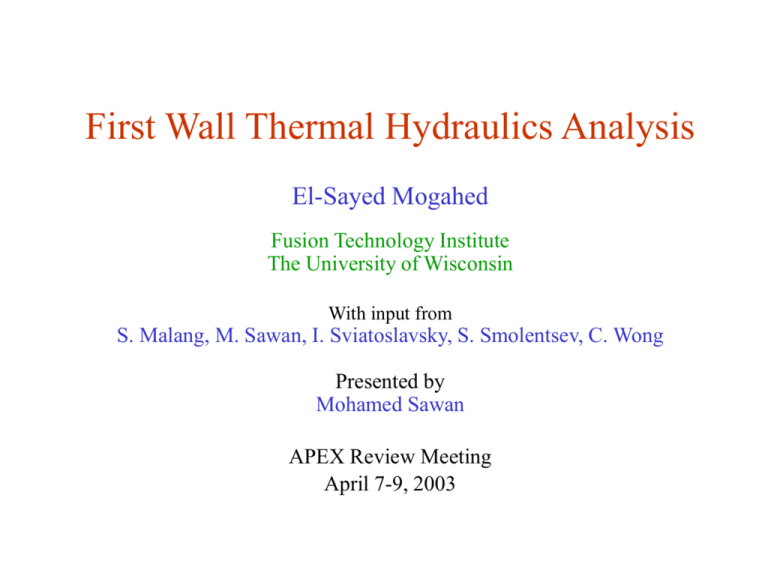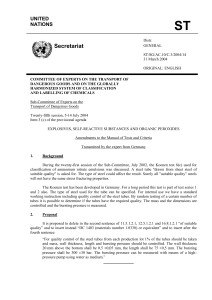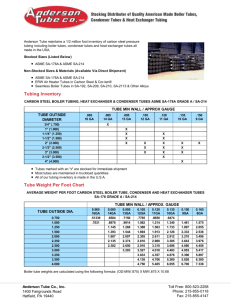Background - UCLA - Fusion Science and Technology Center
advertisement

First Wall Thermal Hydraulics Analysis El-Sayed Mogahed Fusion Technology Institute The University of Wisconsin With input from S. Malang, M. Sawan, I. Sviatoslavsky, S. Smolentsev, C. Wong Presented by Mohamed Sawan APEX Review Meeting April 7-9, 2003 FW Thermal Hydraulics Analysis Considered two options with circular and rectangular FW tubes Assessed improvement resulting from using eccentric Pb tubes in the FW channels Optimized FW channel dimensions to maintain uniform pressure drop (including MHD pressure drop) and uniform Flibe temperature Determined FW thermal hydraulics parameters (pressure drop, velocities, temperatures for the reference rectangular FW channels 2 University of Wisconsin Fusion Technology Institute Diffusion bonded Tube, 3mm thick FLIBE FLIBE LEAD LEAD Conformed back 4 mm thick 30 cm 76 mm Diam. FW 3 mm thick 45.2 mm Lead FLIBE Option with Circular FW Tubes 3 University of Wisconsin Fusion Technology Institute Formulas, parameters, and data used Nu = 0.0118 Pr0.3 Re0.9 For Pr>20 Pressure drop in a vertically moving fluid: DP = r v2/2 + f r L v2/2d where: Nu is the Nusselt number, Pr is the Prandtl number, Re is the Reynolds number, r is the fluid density, v is the coolant velocity, d is the coolant tube hydraulic diameter, and L is the coolant tube length. Flibe properties at 600 °C density = 2120 kg/m3 thermal conductivity = 1 W/mK heat capacity = 2380 J/kg K kinematics viscosity = 5.48e-6 m2/s 4 Radial Distribution of power density in Blanket Components Normalized to Unit Neutron Wall Loading 8 Power Density (W/cm 3) The Blasius friction coefficient, f = 0.3164/Re0.25 10 6 NCF Steel Flibe Lead 4 2 0 0 5 10 15 20 25 30 Depth in Recirculating Blanket (cm) •Nuclear heating profiles used in analysis •Peak neutron wall loading = 5.45 MW/m2 •Peak surface heat flux = 1 MW/m2 •Average OB neutron wall loading = 4.61 MW/m2 •Average IB neutron wall loading = 2.80 MW/m2 •Average OB surface heat flux = 0.95 MW/m2 •Average IB surface heat flux = 0.90 MW/m2 University of Wisconsin Fusion Technology Institute Impact of using eccentric lead tubes in the FW Results in larger cooling sub-channels at the front and smaller ones at the back For the same pressure drop, flow velocity will be larger with higher heat transfer coefficient at front where larger heat load needs to be removed The eccentric configuration was analyzed and compared to the concentric design with the same pressure drop for circular tubes 5 University of Wisconsin Fusion Technology Institute Eccentricity increases velocity at front zone with largest heat load For concentric tubes: Velocity is uniform = 7.21 m/s Pressure drop = 0.585 MPa Zone# 1 Zone# 2 Zone# 3 Zone# 4 Zone# 5 Zone# 6 Zone# 7 6 University of Wisconsin Fusion Technology Institute Eccentricity enhances Flibe temperature uniformity around the multiplier tube Temperature Rise in Different FLIBE Zones 32 Eccentricity = 0.433 mm Pressure drop = 0.585 MPa Temperature Rise (°C) 30 Zone# 1 Zone# 2 28 Zone# 3 Zone# 4 Average Temp. Rise 26 Zone# 5 Zone# 6 Zone# 7 24 22 20 18 1 2 3 4 5 6 7 Zone # 7 University of Wisconsin Fusion Technology Institute Eccentricity reduces the maximum interface temperature between FLIBE and steel Local Interface Temperature Between FLIBE and Steel at Reactor Midplane 660 Eccentricity = 0.433 cm Pressure drop = 0.585 MPa 650 Zone# 1 Zone# 2 FW steel/FLIBE 640 Zone# 3 Zone# 4 Zone# 5 630 Zone# 6 Zone# 7 620 Pb steel/FLIBE 610 600 FLIBE inlet temperature = 590°C 590 580 1 2 3 4 5 6 7 Zone # 8 University of Wisconsin Fusion Technology Institute Analysis for rectangular FW tubes • Design with circular FW tubes is easier to fabricate • Mike Friend calculated stresses in a blanket element, taking into account coolant pressure in FW tubes as well as pressure in the large blanket central duct • While stresses caused by pressure in FW tube itself are lower for the circular tubes, pressure in central duct leads to higher stresses in FW region compared to the rectangular reference design • We optimized the reference rectangular design by using eccentric multiplier tubes and adjusting width of side Flibe channel • MHD pressure drop was included using the results of Sergey’s 2-D calculations • Optimization performed for both OB and IB FW channels 9 University of Wisconsin Fusion Technology Institute Optimized OB Rectangular FW tubes • Size of the Flibe zones surrounding the Pb tube optimized to maintain uniform pressure drop and temperature rise • Total pressure drop is 1.03 MPa • Temperature rise is 30 °C Zone Width Velocity Temp. Total MHD # (mm) (m/s) rise Pressure Pressure (°C) Drop Drop (MPa) (MPa) 1 12.07 8.90 30 1.03 0.32 2 3 10 5 4.93 4.60 4.46 30 30 1.03 1.03 0.41 0.44 University of Wisconsin Fusion Technology Institute Interface Temperatures with Steel in OB Reference Rectangular FW Tubes Zone # Re h (W/m2 K) 1 2 3 39195 8394 8017 18003 10858 10566 Interface temp. Interface temp. between Flibe and between Flibe and outer steel (°C) inner steel (°C) 667 630 611 637 611 633 Interface temp. between Pb and steel (°C) 680 660 662 Volumetric flow rate per tube = 9043 cm3/s Average Flibe velocity at midplane = 6.42 m/s Maximum interface temp. between FLIBE and FW steel = 667 °C Maximum interface temp. between lead and steel = 680 °C 11 University of Wisconsin Fusion Technology Institute Optimized IB Rectangular FW tubes • Higher magnetic field (~8 T compared to ~4.3 T in OB) • Lower heat load compared to OB • Smaller velocity for the same temperature rise of 30 °C • Total pressure drop is 0.88 MPa Zone Width Velocity Temp. Total MHD # (mm) (m/s) rise Pressure Pressure (°C) Drop Drop (MPa) (MPa) 1 13.33 6.11 30 0.88 0.55 2 3 12 4.25 3.67 3.13 3.38 30 30 0.88 0.88 0.51 0.35 University of Wisconsin Fusion Technology Institute Interface Temperatures with Steel in IB Reference Rectangular FW Tubes Zone # Re h (W/m2 K) 1 2 3 29703 4860 4530 12701 7812 8491 Interface temp. Interface temp. between Flibe and between Flibe and outer steel (°C) inner steel (°C) 686 629 611 634 610 627 Interface temp. between Pb and steel (°C) 652 644 638 Volumetric flow rate per tube = 6287 cm3/s Average Flibe velovity at midplane = 4.69 m/s Maximum interface temp. between FLIBE and FW steel = 686 °C Maximum interface temp. between lead and steel = 652 °C 13 University of Wisconsin Fusion Technology Institute Summary Dimensions of FW Flibe channels optimized to maintain uniform pressure drop and temperature rise around the Pb tubes Total FW pressure drop is 1.03 MPa in OB and 0.88 MPa in IB Volumetric flow rate per tube is 9043 cm3/s in OB and 6287 cm3/s in IB Maximum interface temperature between FLIBE and FW steel is 686 °C (in IB module) Maximum interface temperature between lead and steel is 680 °C (in OB module) 14 University of Wisconsin Fusion Technology Institute





